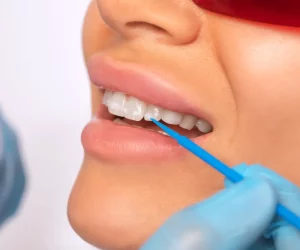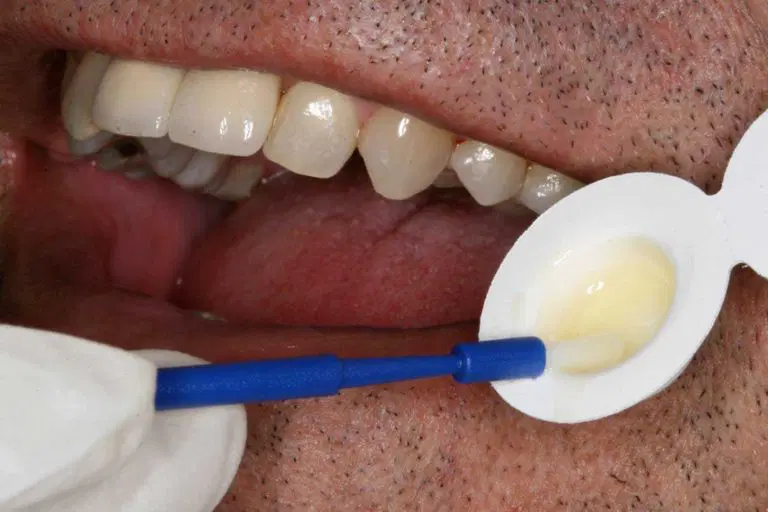888-588-3394
CALL FOR URGENT CARE | BOOK APPOINTMENT
Fluoride Treatment
Fluoride Treatment: A Guide to Preventing Tooth Decay

Understanding Fluoride Treatment
Natural minerals like fluoride are essential for fortifying tooth enamel and increasing its resistance to acid erosion, which can result in tooth decay. It helps restore early damage to tooth surfaces and stop the demineralization that causes cavities by remineralizing them.
The Importance of Fluoride
Dental care cannot be complete without fluoride treatments, particularly for those who are more susceptible to tooth decay. A dental practitioner can apply fluoride varnish, gels, and foams directly to the teeth as one of the several ways of administration for these treatments.
Benefits of Fluoride

Fluoride strengthens and increases the tooth's resistance to decay by integrating into the tooth's structure.

It restores the surface of the tooth by resupplying lost calcium and phosphate, hence repairing early decay.

Preventive care reduces the need for major dental treatments and associated claims.
Who Needs Fluoride Treatment?
-
Medically compromised individuals
-
People who don't practice good dental hygiene
-
People that have previously had cavities
-
Individuals with dry mouths are more likely to experience decay.
-
Individuals receiving radiation therapy, chemotherapy, or orthodontic treatment
At-Home vs. Professional Treatments

Fluoride can be obtained through daily use of fluoride toothpaste and drinking fluoridated water, but fluoride treatments under professional experts of Teledentistry offer a higher fluoride concentration and provide superior protection against cavities.
Age-Specific Recommendations
Children under six years old:
Varnish should be applied to reduce the chance of ingesting it.
Ages 6 to 18:
They can get gel or varnish treatments to safeguard their growing teeth
Adults:
You should think about applying varnish or gel, especially if your tooth has exposed root surfaces or a history of deterioration.
What to Expect During Fluoride Treatment
The fluoride varnish procedure at home involves:
-
Place an order for the kit through the teledentistry platform.
-
Meet with the dental professional via video call.
-
Seek guidance from the dental professional.
-
Schedule follow-up virtual consultations as needed.
-
The dental professional documents the consultation and treatment in your records for future reference.
The fluoride varnish procedure in a dental clinic involves:
-
Preparation and examination of the patient.
-
Cleaning the teeth to remove plaque.
-
Isolating the teeth for better application.
-
Applying fluoride varnish to all tooth surfaces.
-
Drying the varnish with air.
-
Providing post-application instructions.
-
Scheduling follow-up treatments as needed.
-
Documenting the treatment in the patient's records.
-
Educating the patient on oral hygiene.

Fluoride Gel or Foam
The fluoride substance is applied to the teeth for many minutes after being placed on a tray for this treatment. For the fluoride to take effect completely, it's crucial to wait 30 minutes after treatment before eating or drinking anything.
Risks and Alternatives
Fluoride treatments are safe and effective, but excessive use might have negative consequences. When treatments are administered by professionals, this is uncommon, nevertheless. Dental sealants, appropriate diet, and excellent oral hygiene are alternatives to fluoride treatments.
Preventing Tooth Decay
Regular dental exams, good brushing and flossing techniques, and reducing the consumption of sugary and acidic foods are all preventive methods against tooth disease. Fluoride treatments provide an additional layer of defense, particularly for people who are more susceptible to tooth cavities.FAQ
A naturally occurring mineral called fluoride aids in tooth development and guards against cavities. It combats the microorganisms that damage teeth and gums and maintains the integrity of each tooth's outer layer of protection, or tooth enamel. By remineralizing tooth surfaces, fluoride treats early decay before it progresses to cavities.
Those who have a high risk of tooth decay, such as those who have poor dental hygiene, a history of cavities, dry mouth, are receiving orthodontic treatment, or have received chemotherapy or radiation therapy, benefit most from fluoride treatments. Nevertheless, fluoride's ability to prevent cavities is beneficial to everyone.
For people who are at a high risk of dental cavities, the American Dental Association (ADA) advises getting professional fluoride treatments at least every 3 to 6 months. Personalized guidance will be provided from the teledentistry dental experts based on your unique risk factors and dental health condition.
Ordering fluoride varnish kits through teledentistry is simple. You can request us through the teledentistry website or contacting teledentistry customer care.
Yes, you will be under the supervision of our dental experts through virtual consultation throughout the process.
Dental fluorosis occurs when children consume too much fluoride over long periods while their teeth are developing under the gums. This condition is not caused by professional fluoride treatments but by ingesting fluoride, usually from sources like water or dental products. It's important to monitor the amount of fluoride children ingest.
Fluoride treatments are generally safe. Some people might experience a temporary change in taste or mild irritation in their mouth, but serious side effects are rare. Ensuring that fluoride treatments are applied by a professional minimizes the risk of adverse effects.
After a fluoride varnish treatment, it's recommended to wait at least 4 to 6 hours before eating or drinking, and to avoid hard, crunchy, or hot foods and beverages. For fluoride gels or foams, you should not eat or drink for at least 30 minutes following the treatment.
Besides professional treatments, you can get fluoride from over-the-counter toothpaste and mouth rinses. Some people may also benefit from prescription-strength fluoride products, especially if they don't have access to fluoridated water or are at high risk of tooth decay.
Even individuals with excellent oral hygiene can benefit from fluoride treatments, as they provide an additional layer of protection against tooth decay. Discuss with your dentist to determine how fluoride treatments can fit into your overall oral health strategy.
Factors that increase the risk of tooth decay include poor oral hygiene, frequent snacking on sugary foods or drinks, dry mouth, existing cavities, and certain health conditions. Your dentist can assess your risk and recommend appropriate fluoride treatments.
Yes, adults can benefit from fluoride treatments, especially those with conditions that put them at higher risk for tooth decay, such as dry mouth, gum disease, or a history of frequent cavities. Fluoride treatments can help protect adult teeth from decay and strengthen tooth enamel.
Insurance Carriers
- AETNA
- Aflac
- BENECARE
- Blue Cross Blue Shield IL,MT, NM, OK, TX (DEARBORN GROUP)
- Blue Cross Blue Shield Arkansas
- Blue Cross Blue Shield Florida
- Blue Cross Blue Shield HMSA
- BRECKPOINT
- COLONIAL
- Delta Dental of Arizona
- Delta Dental of Colorado
- Delta Dental of Connecticut
- Hawaii Dental Service
- Delta Dental of Iowa
- Delta Dental of Idaho
- Delta Dental of Illinois
- Delta Dental of Illinois - Individual
- Delta Dental of Massachusetts
- Delta Dental of Missouri
- Delta Dental of New Jersey
- Delta Dental of New Mexico
- Delta Dental of Virginia
- Delta Dental of Michigan
- Northeast Delta Dental
- Kaiser Permanente
- DENTAQUEST
- DIRECT DENTAL ALLIANCE
- GEHA
- GUARDIAN
- Hi Hit Trust
- LIBERTY DENTAL PLAN
- NEVADA DENTAL BENEFITS
- PATIENT DIRECT
- PRIMECARE
- SUNLIFE
- TruAssure
- UNITED CONCORDIA
- UNUM
Top Dental Emergencies
- Abrasion
- Bite Class
- Calculus
- Cavities
- Decalcification and White Spot Lesions
- Dental Plaque
- Erosion
- Fillings
- Gum Disease
- Inflammation and oral lesions
- Overcrowding
- Periodontitis
- Gum Recession
- Root exposure
- Soft Tissue Lesions
- Stained Discolored Teeth
- Teeth Spacing
- Teeth Straightening
- Third molars/Wisdom teeth
To view our privacy policy and terms of use, please visit the following link: Privacy Policy.
Español »


